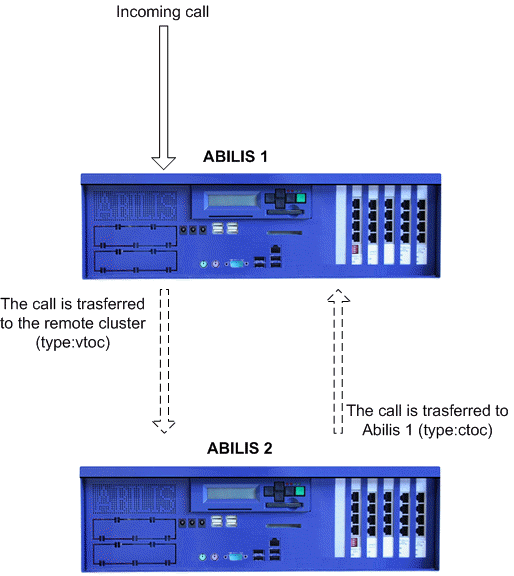| 46.4. CTI Cluster | ||
|---|---|---|
 | Chapter 46. CTI System |  |
A “Cluster” identifies a connection, used to transport compressed phone calls, between two Abilis. Each cluster is identified with a clear label registered in the Abilis configuration.
Cluster names basically are made from 1 to 8 characters in the range '0'..'9', 'A'..'Z', 'a'..'z', '_', ':', but to support unified namespace we have to exclude the following combinations:
Internal names used for special ports: Iax, Sip, Disa, Vo, Vm, Vr, Mix, Sl (and Slink), PBX. Case insensitive
Names composed of just 1 or 2 or 3 numbers, e.g. 1,21,999
Names Gn and Gnn with n=number, e.g. G1 and G99. Case insensitive
Names G*, *, **, #. Case insensitive
Names Vsp-n, Vsp-nn, Vsp-nnn, used for virtual synchronous port. Case insensitive
Names that start with < or '. Btw, < and ' are character already prohibited for cluster names
The following commands to manage the CTI Clusters use:
a cticl id:xx [par:value]: adds a new CTI Cluster
s cticl id:xx [par:value]: sets a CTI Cluster
c cticl id:xx : clears a CTI Cluster
d cticl: displays the CTI Cluster table
The d cticl ? command shows all available parameters.
The example below shows how to add the cluster Abilis2
(the number associated with the cluster is 0123456).
[15:17:02] ABILIS_CPX:a cticl id:Abilis2 descr:Cluster_to_Abilis2 num:0123456COMMAND EXECUTED [15:17:32] ABILIS_CPX:d cticl- Not Saved (SAVE CONF), Not Refreshed (INIT) --------------------------------- Configured Clusters:6 Activated Clusters:8 ---------+----------------------+----+-----+--------+-------------+------------ CLUS: |[DESCR:] [ID:] |NUM-IN-REWRITE: |SS: |CPO: |RG-IN: |BUSY-ON-MAX: |CLIP-RULE: |NUM: |PC: |LCS-GROUP: |ADDRBOOK-NUM: |NUMx: ---------+----------------------+----+-----+--------+-------------+------------ Abilis2 [Cluster_to_Abilis2 NO NO DISABLE NO PRIVATE [ 1] ue* NO NONE NUM 0123456
Meaning of the most important parameters:
CG-IN-REWRITERewrites the calling number received from the cluster, after NUMx and NUM processing.
RG-INEnable/disable management of incoming redirecting [DISABLE, ENABLE].
SSEnable/disable supplementary services [NO, YES].
Sets for which direction the Call Path Optimization is allowed [NO: Call Transfer isn't sent out and it's ignored in input, IN: Call Transfer is accepted in input but it isn't sent out, OUT: Call transfer is sent out but it's ignored in input, BID: Call Transfer is sent out and it's accepted in input].
NUMPhone number assigned to the CTI cluster. The available values are:
*: the Calling Number offered by CTIR
is passed transparently to the device;
#: the Calling Number isn't passed to
the device;
##: enforces the presentation
restricted: the Calling Number isn't passed to the
device;
nnnn: exactly this number is passed as
Calling Number to the device;
nnnn*: the Calling Number received from
CTIR is modified by replacing first four digits with
nnnn;
nnnn??: similar to
nnnn* with the difference that only an exact
number of digits as many ? is passed after
nnnn;
????: only an exact number of digits as
many ? is passed after the
nnnn.
NUMxadditional phone number(s) assigned to this cluster.
LCS-GROUPLast Calling number Service group identifier [NONE, 1..32]
BUSY-ON-MAXReturn BUSY cause when MAXCON or MAXBW are exceeded [NO, IN, OUT, BID]
CLIP-RULESpecifies the treatment of the CG number for calls TO the cluster (OUTGOING) [PRIVATE, PUBLIC]. If PRIVATE the CG is sent unmodified, if PUBLIC the CG is emptied when PI is set to RESTRICTED.
A list of cluster numbers
(NumClus) is automatically generated by the system; it
contains the correspondence between Clusters and their respective
numbers.
[15:22:55] ABILIS_CPX:d listLast change: 22/04/2015 14:22:37 CET Used-Lists: 1 Used-Items: 0 Used-Resources: 80 (byte) Free-Lists:249 Free-Items: 4000 Free-Resources: 645040 (byte) Id Name Type Description Edt St RefN. First Numb ---+----------------+------+--------------------------+---+--+-----+-----+----- 1 NumClus CLNUM Automatically_generated... R 3 0 1 ------------------------------------------------------------------------------- IN:ISDN Numbers, XN:X25 NUAs, CR:CPX resources, INN:ISDN Numbers Normalized, XU:X25 UDFs, EC:CTI Clusters, IS:ISDN Sub Addresses, IP:IP Addresses, MAC:MAC Addresses, INR:ISDN Numbers Replacements, IR:IP Addresses Ranges, DN:Dialing Numbers, IN2T:ISDN Numbers to Text, IPT:Internet Protocols, TXT:Text, CLNUM:CTI Clusters Numbers, TUP:TCP/UDP ports ranges, ICAUSE:ISDN Cause codes, ICMPT:ICMP message Types, RU:Rules, OPC:OPC Unique User IDs, MR:Master Rules. ------------------------------------------------------------------------------- [15:29:34] ABILIS_CPX:d list:NumClusLIST:NumClus - CLNUM - Ref-Numb:3 Items-Numb:1 Automatically_generated_CTI_Clusters_Numbers_list_(ReadOnly) -------------------------------------------------------------------------- 0123456 Abilis2
This list can be used to simplify the structure of the CTI Routings: a unique rule can route all the calls for the Clusters, by verifying the called number configured. See the example in the CTI Routing section further details.
![[Caution]](../images/caution.png) | Caution |
|---|---|
Changes made on the CTI Clusters aren't immediately active. To activate them, execute the initialization command init ctisys. |
The call path optimization allows to optimize the path of calls. Supposing to have the following scheme:

A call is received by Abilis 1 and the operator routes the call toward Abilis 2. Then the remote user reroutes the call toward the Operator. Without CPO the calls (one from Abilis 1 to Abilis2 and one from Abilis 2 to Abilis 1) remain active and can cause a degradation of the quality.
With CPO active the calls drawn with dotted lines are closed and the initial one remains active.